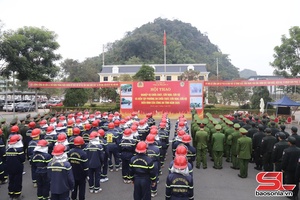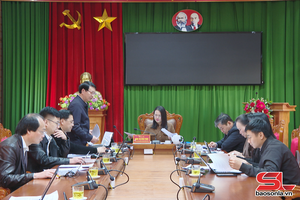Accompanying the working delegation were members of the provincial Party Committee’s Standing Board, leaders of the provincial People’s Committee, and representatives of provincial departments and agencies.


In Thao Nguyen ward, the leaders surveyed the site for the implementation of the Model Urban Area project, covering nearly 98 hectares with an expected population of around 5,000. The project features a fully synchronised technical infrastructure system integrated with social infrastructure facilities. With a total investment of more than 3.67 trillion VND (139.3 million USD), sourced from the investor and other lawful mobilised funds, the project has a 50-year contract term and a construction and business period of 15 years.
Nghiem requested the investor to focus resources to ensure timely progress, quality, and overall consistency, contributing to the completion of infrastructure for the Moc Chau National Tourism Area and creating momentum for development as well as a new urban appearance for Thao Nguyen ward.

The delegation then visited the Bon Bon Farm community-based tourism model of Bon Bon Agricultural Tourism Cooperative in Vat Hong residential area, Moc Chau ward; visited an agricultural-based tourism development model at Mocha Hill Tourist Area; and surveyed the implementation of the road project connecting National Highway 6 through the Peach Garden Sub-area of the former Moc Chau Farm town to Thuong Cuong hamlet in the former Van Ho commune.
They also surveyed the proposed site for the construction of the Square and the headquarters of the Party Committee, People’s Council, People’s Committee, and Vietnam Fatherland Front Committee of Van Son ward, located in Bo Bun residential area of Van Son ward.
.jpg)

Provincial leaders survey the proposed site for the construction of the Square and the headquarters of the Party Committee, People’s Council, People’s Committee, and Vietnam Fatherland Front Committee of Van Son ward.
The provincial Party leader requested relevant units to review planning to ensure architectural harmony, structural consistency, and long-term usability, contributing to the development of the wards in a modern and civilised direction. He also appreciated the localities’ creative approaches in utilising natural landscapes in combination with experiential farms and distinctive eco-services; promoting high-tech agricultural applications; and introducing new crop varieties into production.
He expressed his hope that agricultural experience tourism models would continue to create new highlights for the Moc Chau National Tourism Area, contributing to sustainable economic development and improving the incomes of local residents.























You have 500/500 characters left
Please enter 5 or more characters!!!